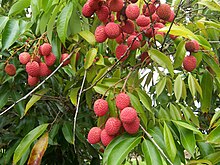Nephelium litchi
| Lychees | |
|---|---|
 |
|
| Scientific classification | |
| Kingdom: | Plantae |
| (unranked): | Angiosperms |
| (unranked): | Eudicots |
| (unranked): | Rosids |
| Order: | Sapindales |
| Family: | Sapindaceae |
| Subfamily: | Sapindoideae |
| Genus: |
Litchi Sonn. |
| Species: | L. chinensis |
| Binomial name | |
|
Litchi chinensis Sonn. |
|
| Lychee | |||||||||||||||||||||||||||

"Lychee" in Chinese characters
|
|||||||||||||||||||||||||||
| Chinese | 荔枝 | ||||||||||||||||||||||||||
|---|---|---|---|---|---|---|---|---|---|---|---|---|---|---|---|---|---|---|---|---|---|---|---|---|---|---|---|
|
|||||||||||||||||||||||||||
| Transcriptions | |
|---|---|
| Standard Mandarin | |
| Hanyu Pinyin | lìzhī |
| Gwoyeu Romatzyh | lihjy |
| Wade–Giles | li4-chih1 |
| IPA | [lî.ʈʂɨ́] |
| Yue: Cantonese | |
| Yale Romanization | laih-jī |
| IPA | [lɐ̀i.tsíː] |
| Jyutping | lai6-zi1 |
| Southern Min | |
| Hokkien POJ | nāi-chi |
| Tâi-lô | nāi-tsi |

|
|
| Nutritional value per 100 g (3.5 oz) | |
|---|---|
| Energy | 276 kJ (66 kcal) |
|
16.53 g
|
|
| Sugars | 15.23 g |
| Dietary fiber | 1.3 g |
|
0.44 g
|
|
|
0.83 g
|
|
| Vitamins | |
| Thiamine (B1) |
(1%)
0.011 mg |
| Riboflavin (B2) |
(5%)
0.065 mg |
| Niacin (B3) |
(4%)
0.603 mg |
| Vitamin B6 |
(8%)
0.1 mg |
| Folate (B9) |
(4%)
14 μg |
| Vitamin C |
(86%)
71.5 mg |
| Minerals | |
| Calcium |
(1%)
5 mg |
| Iron |
(1%)
0.13 mg |
| Magnesium |
(3%)
10 mg |
| Manganese |
(3%)
0.055 mg |
| Phosphorus |
(4%)
31 mg |
| Potassium |
(4%)
171 mg |
| Sodium |
(0%)
1 mg |
| Zinc |
(1%)
0.07 mg |
|
Link to USDA Database entry
Vitamin B6/Folate values were available |
|
|
|
| Percentages are roughly approximated using US recommendations for adults. Source: USDA Nutrient Database |
|
Lychee (variously spelled litchi, liechee, liche, lizhi or li zhi, or lichee) (Litchi chinensis; Chinese: 荔枝; pinyin: lìzhī) is the sole member of the genus Litchi in the soapberry family, Sapindaceae.
It is a tropical tree native to the Guangdong and Fujian provinces of China, where cultivation is documented from 1059 AD. China is the main producer of lychees, followed by India, other countries in Southeast Asia, the Indian Subcontinent and South Africa.
A tall evergreen tree, the lychee bears small fleshy fruits. The outside of the fruit is pink-red, roughly textured and inedible, covering sweet flesh eaten in many different dessert dishes. Since the perfume-like flavor is lost in the process of canning, the fruit is usually eaten fresh.
Lychee contains many . The seeds have been found to contain methylenecyclopropylglycine which can cause hypoglycemia, while outbreaks of encephalopathy in Indian and Vietnamese children have also been linked to its consumption.
Litchi chinensis is the sole member of the genus Litchi in the soapberry family, Sapindaceae. It was described and named by French naturalist Pierre Sonnerat in his account "Voyage aux Indes orientales et à la Chine, fait depuis 1774 jusqu'à 1781" (translation: "Voyage to the East Indies and China, made from 1774 to 1781"), which was published in 1782. There are three subspecies, determined by flower arrangement, twig thickness, fruit, and number of stamens.
...
Wikipedia
